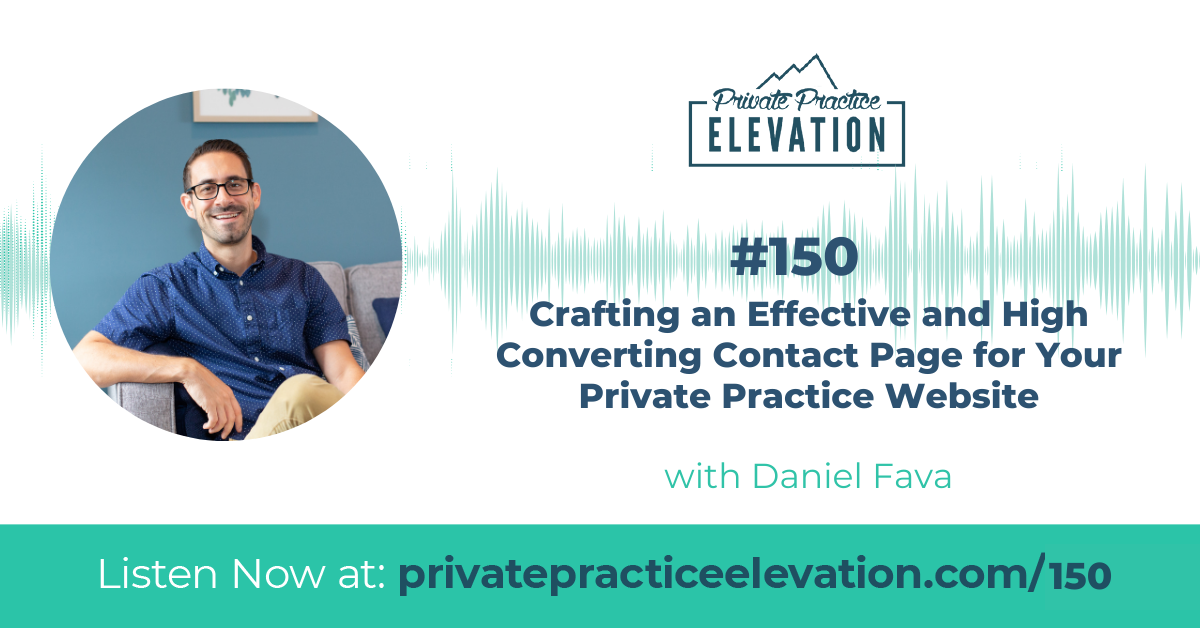In this episode of the Private Practice Elevation Podcast, we are delving deep into the art of crafting an effective and high-converting contact page for your private practice website.
Your private practice website is more than just an online presence or an online business card. It is your gateway to connecting with clients, helping them find the support they need, and ultimately growing your private practice.
At the heart of this journey lies your contact page, a crucial element in the conversion process on your website.
Your contact page is where visitors take that crucial step of reaching out and booking appointments or learning more about your practice.
It is not just about design; it is about creating a seamless, inviting experience that encourages visitors to take action.
In this episode, Daniel Fava explores ten tips to help you create a seamless and inviting contact page that encourages visitors to take that crucial step of reaching out and booking appointments or learning more about your therapy practice.
Key Takeaways:
- Keep the contact page simple and inviting to avoid overwhelming visitors.
- Prioritize the contact form by prominently displaying it above the fold.
- Create an engaging headline that incites action and leads visitors to the contact form.
- Provide multiple contact options, such as phone, email, and a contact form, to cater to different preferences.
- Add trust-building elements, such as testimonials or certifications, to instill confidence in visitors.
- Use a clear call to action on buttons to let visitors know what will happen when they click.
- Optimize the contact page for mobile devices to accommodate the majority of users.
- Ensure privacy and security by mentioning your commitment to privacy and using SSL encryption.
- Implement CAPTCHA or other spam protection measures to prevent unwanted submissions.
- Test and monitor the contact page to track conversions and make improvements over time.
This Episode Is Brought To You By
Alma is on a mission to simplify access to high-quality, affordable mental health care by giving providers the tools they need to build thriving in-network private practices. When providers join Alma, they gain access to insurance support, teletherapy software, client referrals, automated billing and scheduling tools, and a vibrant community of clinicians that come together for education, training, and events.
Alma gives clinicians the tools they need to build thriving private practices. When you join their insurance program, you can get credentialed within 45 days, and access enhanced reimbursement rates with major payers. They also handle all of the paperwork, from eligibility checks to claims submissions, and guarantee payment within two weeks of each appointment.
In addition to their insurance program, Alma offers timesaving tools and administrative support — so you can spend less time on paperwork, and more time delivering great care to your clients.
Learn more about building a thriving private practice with Alma at helloalma.com/elevation.
10 Tips For Crafting an Effective and High Converting Contact Page for Your Private Practice Website
1. Keep it Simple and Inviting
The first rule of an effective contact page is to keep it simple.
We want to create a clean and uncluttered design that invites visitors in and makes it clear what they need to do on the page. Look at other websites, both within your industry and outside of it, to get ideas on how to create a simple and inviting contact page.
The goal is to make it easy for visitors to understand what they need to do and to lead them into taking that next step.
2. Prioritize the Form
The contact form is the main attraction of your contact page. It should be prominently displayed, preferably above the fold, so that visitors can easily find it without scrolling down. Include fields for name, email, phone number, and a message box for longer messages.
Over time, you can customize the form to fit the specific needs of your practice, such as asking for the best time to call back for a consultation. The key is to keep the form simple and efficient for your practice.
3. Create an Engaging Headline
At the top of your contact page, create an engaging headline that invites action. This could be something like “Ready to take the first step towards a happier you?” or “Get in touch to schedule your free consultation.”
The goal is to incite action and lead visitors to the contact form, which should be prominently displayed right below the headline.
4. Provide Multiple Contact Options
While the contact form is the main focus of your contact page, it is important to offer multiple contact options to cater to different preferences.
Some visitors may prefer speaking directly, while others may be more comfortable with written communication.
Along with the contact form, include options such as phone, email, and even a link to your Google Business profile. This allows visitors to choose the method of contact that they are most comfortable with.
5. Add Trust Building Elements
Building trust is crucial in encouraging visitors to take that next step and reach out. Consider adding trust-building elements to your contact page, such as testimonials, certifications, or social proof.
Testimonials from past clients can help potential clients feel more confident in reaching out, knowing that others have had positive experiences with your practice.
Certifications and social proof, such as being featured on reputable websites or podcasts, can also help build trust.
6. Use a Clear Call to Action
Your contact page should have a clear call to action on the button that leads visitors to take the next step.
Use phrases like “Get started” or “Request an appointment” to make it clear what will happen when the button is clicked. Avoid being too creative or fancy with the call to action; simplicity is key.
Make sure the button stands out against the rest of the page and is easy to click, especially on mobile devices.
7. Optimize for Mobile
With the majority of people accessing websites from their smartphones, it is crucial to optimize your contact page for mobile devices.
Ensure that your contact page and the form are fully responsive, easy to navigate, and function seamlessly on mobile devices.
Test the contact form on your own phone and ask others to do the same to ensure a smooth user experience.
8. Privacy and Security
Visitors to your website need to feel confident that their information is secure and will not be shared without their consent. Mention your commitment to privacy and include a link to your privacy policy under the contact form. Additionally, make sure your website is secure with an SSL certificate to encrypt information that is submitted through the contact form.
9. CAPTCHA and Spam Protection
Implementing CAPTCHA or other spam protection measures on your contact form is essential to prevent unwanted submissions and maintain the quality of inquiries. CAPTCHA helps filter out bots that try to spam your contact form by requiring users to complete a simple math equation. This ensures that only genuine inquiries are submitted through the form.
10. Test and Monitor
After implementing these tips, it is important to test and monitor the performance of your contact page.
Use tools like Google Analytics to track user behavior and conversion rates. Monitor how many people land on your contact page and how many actually submit the form.
This data will give you insights into the effectiveness of your contact page and help you make any necessary adjustments.
Conclusion
Crafting an effective and high-converting contact page is crucial for growing your private practice.
By keeping it simple and inviting, prioritizing the form, providing multiple contact options, adding trust building elements, using a clear call to action, optimizing for mobile, ensuring privacy and security, implementing CAPTCHA and spam protection, and testing and monitoring the performance, you can create a contact page that encourages visitors to take that crucial step of reaching out.
Continuously evaluate and improve your contact page to maximize conversions and grow your practice.



